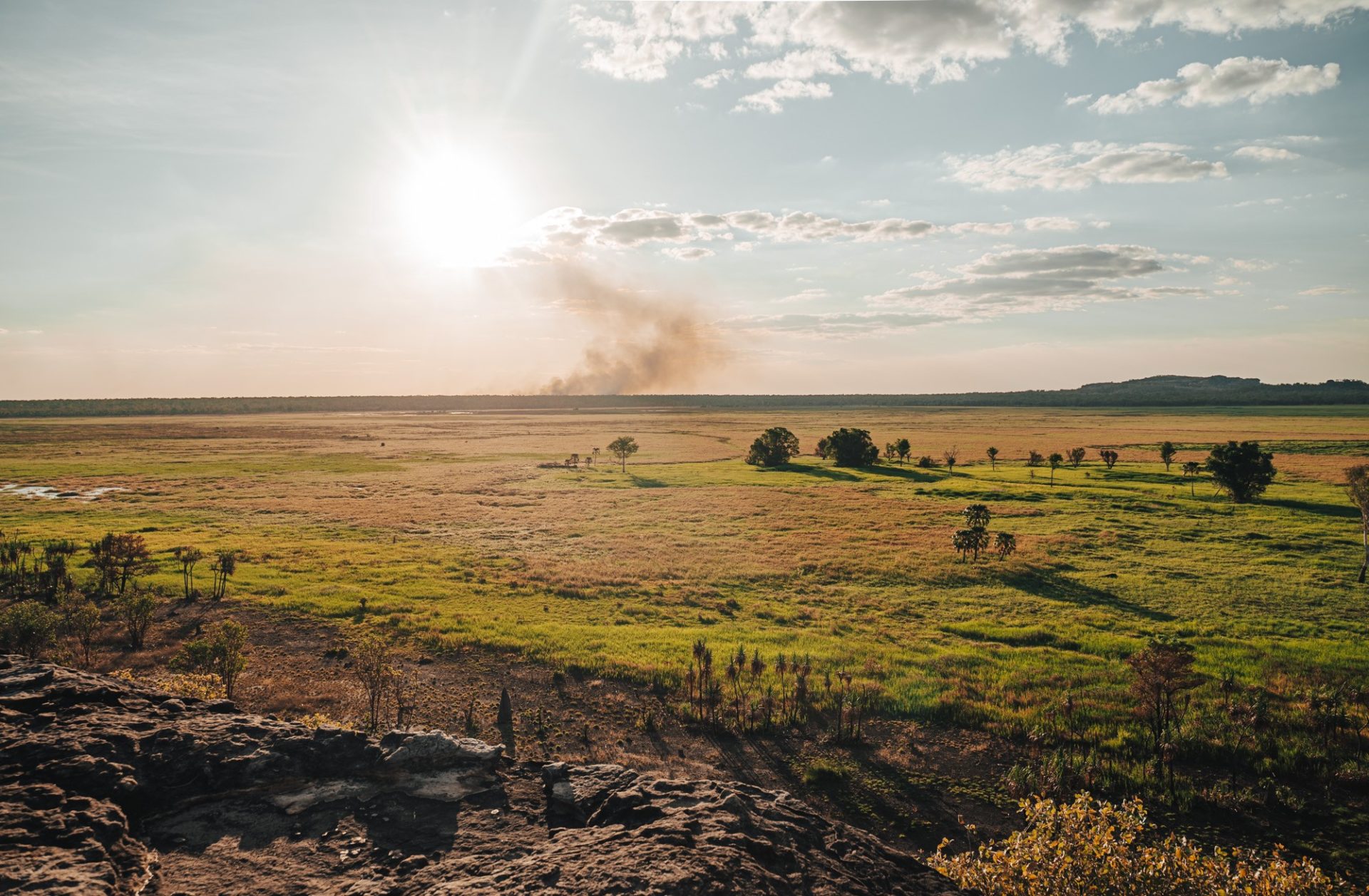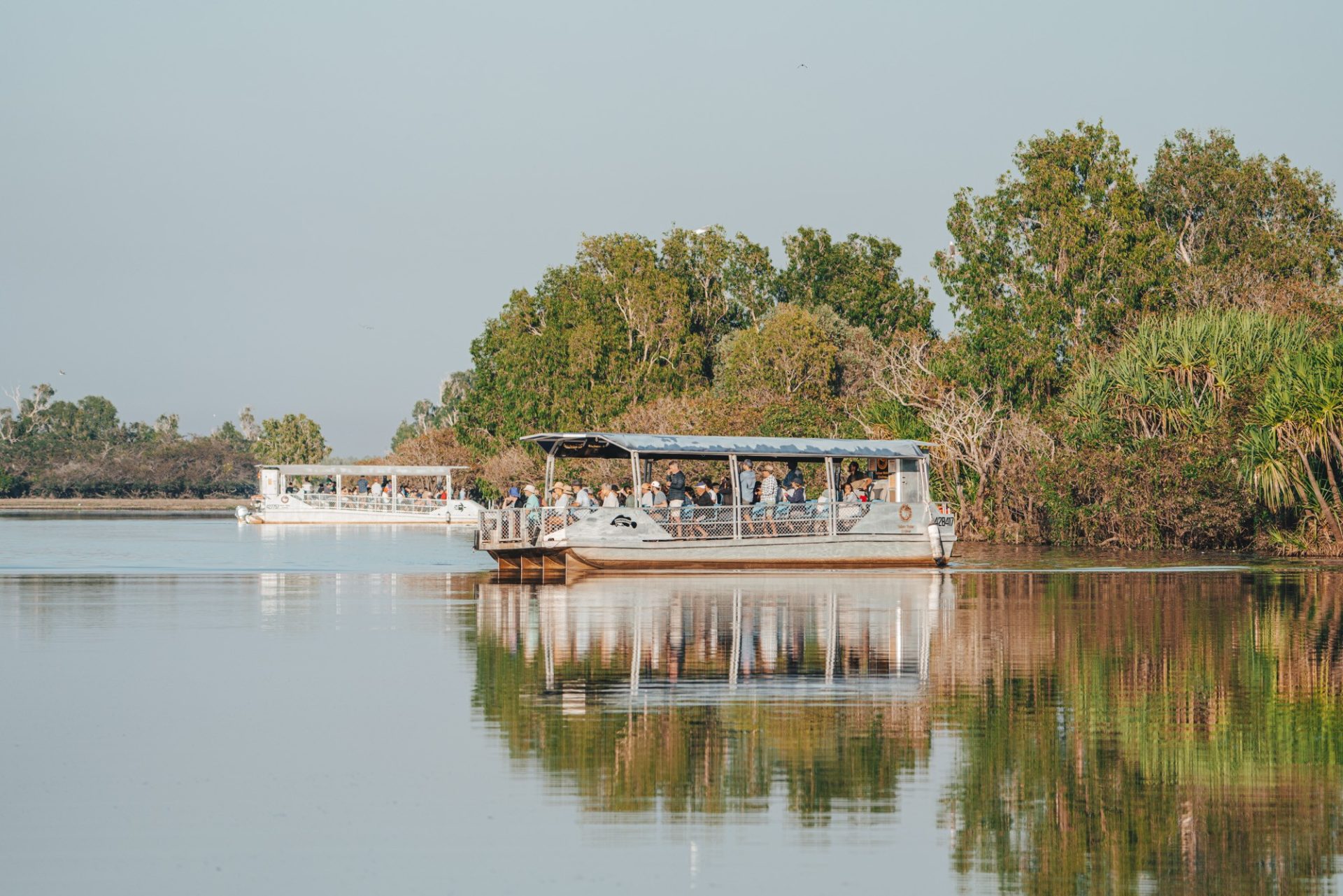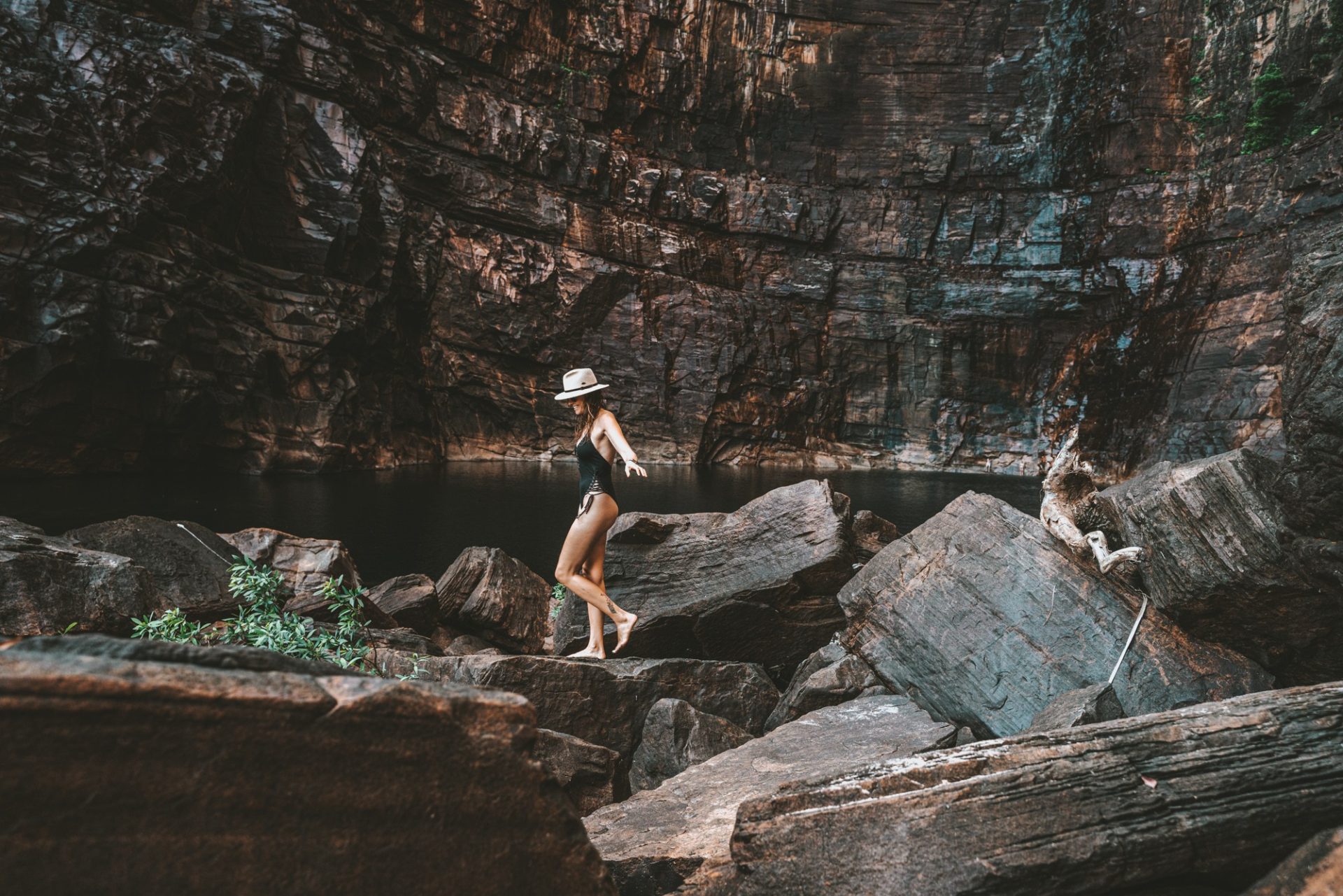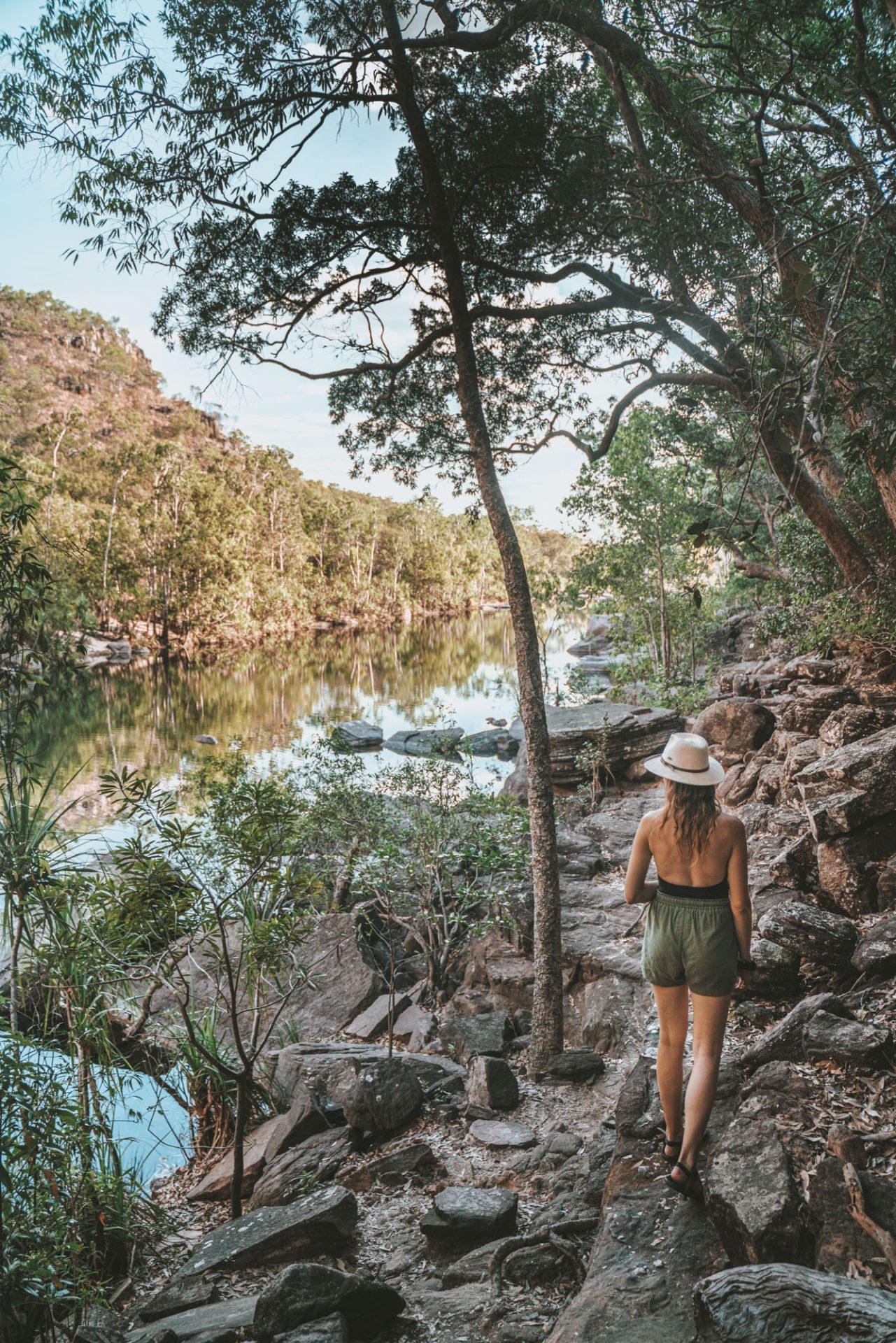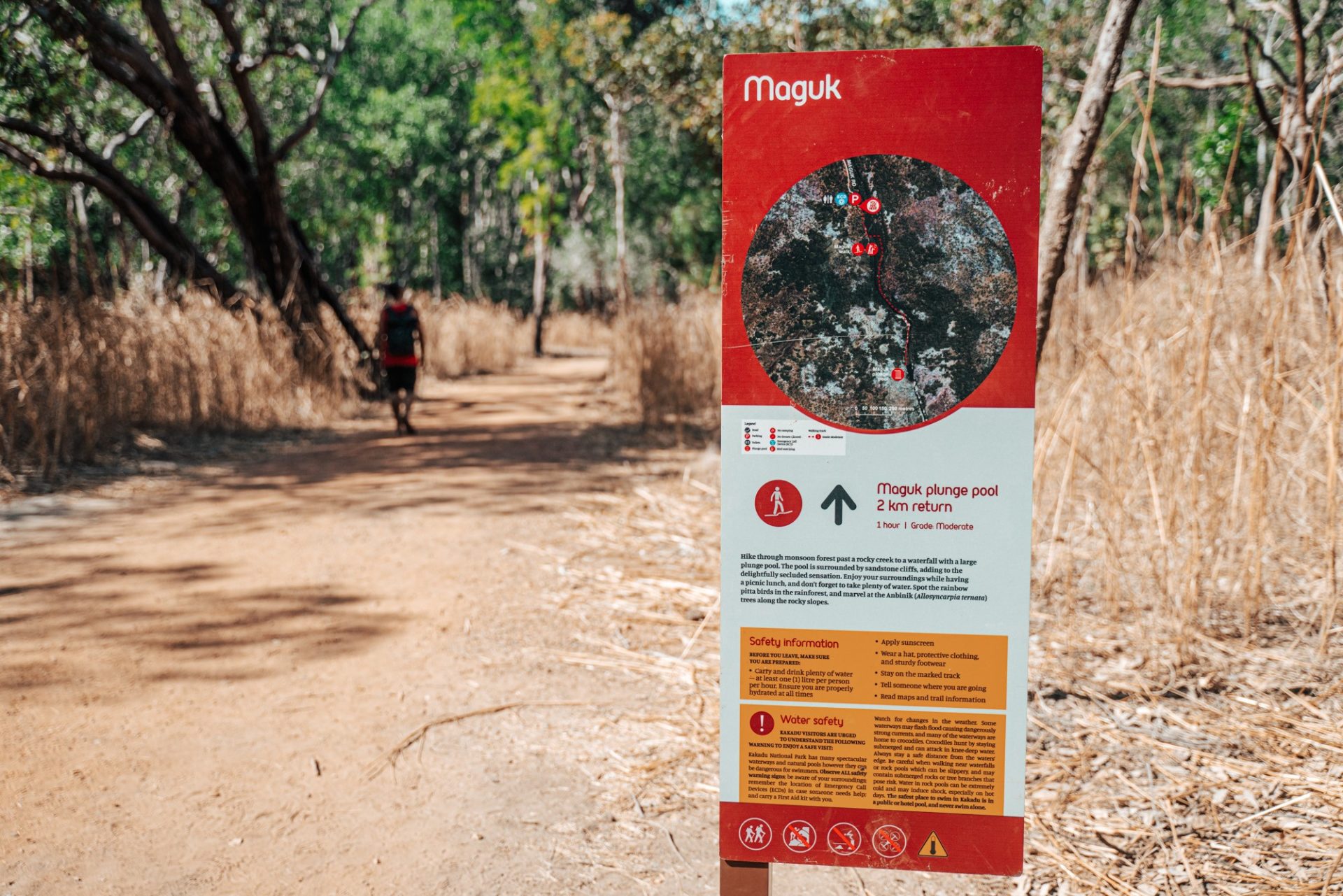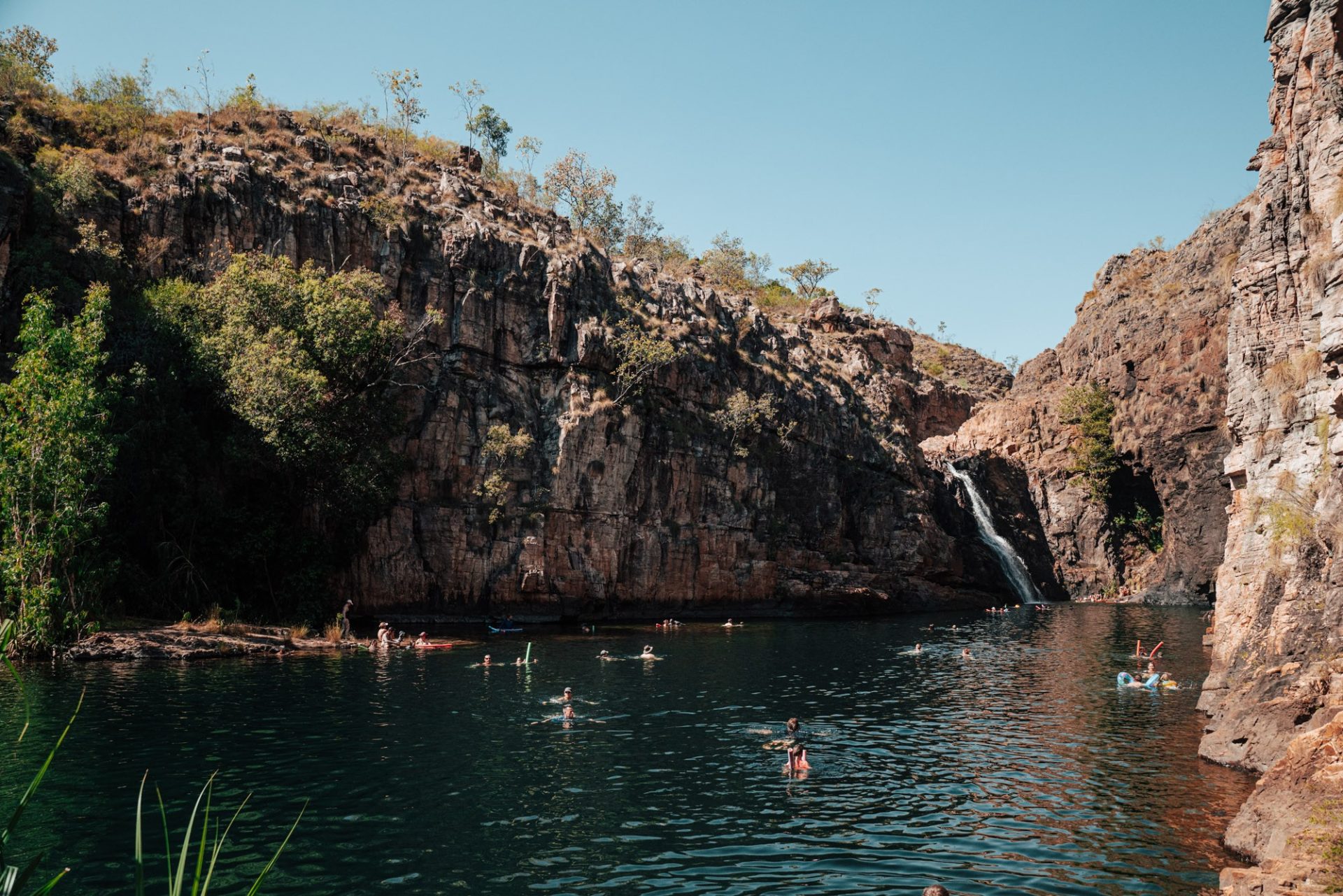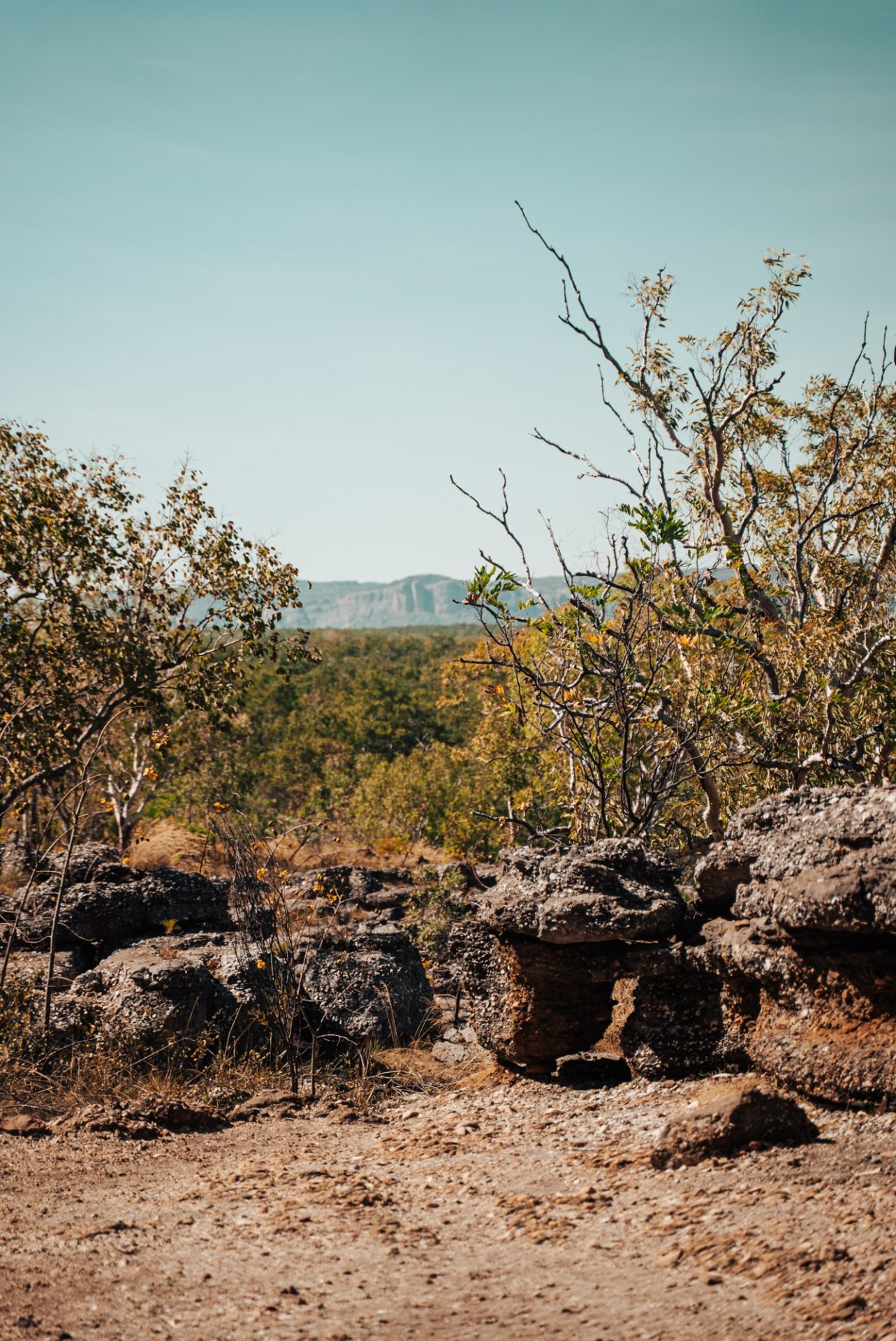Kakadu National Park is Australia’s biggest national park. The huge 20, 000 square-kilometre park is the traditional home of the Bininj/Mungguy people, who have called this part of the Northern Territory’s Top End home for tens of thousands of years.
*This post may contain affiliate links, as a result, we may receive a small commission (at no extra cost to you) on any bookings/purchases you make through the links in this post. As an Amazon Associate, we earn from qualifying purchases. Read our full disclosure
Kakadu is one of 20 UNESCO World Heritage’s list of places in Australia, in recognition of its outstanding natural and cultural values.
Kakadu National Park is located just over 150km southeast of Darwin and is jointly managed by the Aboriginal Traditional Owners and Parks Australia. A visit to Kakadu is one of the best ways to gain a deeper understanding of the oldest living culture in the world, with some of the most incredible Aboriginal rock art sites found within the park.
For nature lovers, Kakadu also has some incredible landscapes including wetlands, and rocky escarpments. The park is also home to a variety of wildlife, ranging from crocodiles to an incredible diversity of birds.
We visited Kakadu National Park on our road trip around the Top End and were lucky enough to spend some time exploring the attractions inside the park. If you’re planning a visit to this incredible must-see national park in Northern Territory, this guide covers everything that you need to know about visiting Kakadu.
Traveling Soon? Here is a list of our favourite travel providers and accessories to help get you ready for your upcoming trip!
How to Get to Kakadu National Park
The park boundary of Kakadu National Park is just over 150km (93 miles) southeast of Darwin on the Arnhem Highway. If you’re coming from Katherine and Pine Creek further south, it’s just around 150km (93 miles) to the park entrance on Kakadu Highway. Both the Arnhem and Kakadu Highways are the only two sealed roads through the national park, meeting at Jabiru, the main town inside Kakadu.
While there are scenic flights available in the national park, there is no official airport. So, you’ll have to fly into Darwin and hire a car from there.
READ NEXT: Sustainable City Guide: Things To Do In Darwin, Australia
Getting Around Kakadu National Park
The huge expansive national park has very limited road networks and a remote off-road experience is required to explore some of the park. Getting around is much easier for those with a 4WD or high clearance vehicle, as there are parts of the park with unsealed roads, including the major sights such as Jim Jim Falls.
The central hub of Kakadu is the town of Jabiru, where the Arnhem Highway and Kakadu Highway converge. Both higways are sealed and in good condition. The town has a number of accommodation options and restaurants and plays host to the park’s Visitor Centre. From Jabiru, there are a number of attractions, walks, and experiences easily accessible via a sealed road suitable for any 2WD vehicle.

Tours to Kakadu
Public transportation inside the park is non-existant, so a car is manadtory to explore the region. If you do not feel comfortable driving in the Top End, consider joining a tour. There are a number of day trips to Kakadu and multi-day adventures available from Darwin that include transportation to the park and around the park.
Entrance fees and passes
Park passes are needed to visit Kakadu National Park. Passes are available online or at one of the Visitor Centres inside the park. They are valid for 7 days with the price differing between the dry season and tropical wet season.
During the popular dry season, the park pass is $40 per person. The Kakadu entry fee drops to $25 per person during the wet season from November until May.
While the national park is technically open 24/7, some of the individual attractions such as Ubirr and Burrungkuy (Nourlangie rock) have restricted opening hours from 8.30 am to 7 pm.
What is the Best Time to Visit Kakadu National Park
The traditional owners of the Kakadu region, the Bininj/Mungguy people, recognize six different seasons in the national park. They can be divided into two general seasons, the dry and the wet.
Most people consider the dry season to be the best time to visit Kakadu National Park. The dry season runs from May until October. This is when the skies are clear and the days are warm. It’s also the high tourism season for the entire Top End region.
The wet season runs from November to April and can also be a very nice time to visit. The monsoonal rains bring the wetlands and waterfalls to life, and you can experience next to no crowds at all. Although you will need to be aware of road closures and other limitations of traveling at this time. A 4WD vehicle is highly recommended if visiting Kakadu during the wet season.
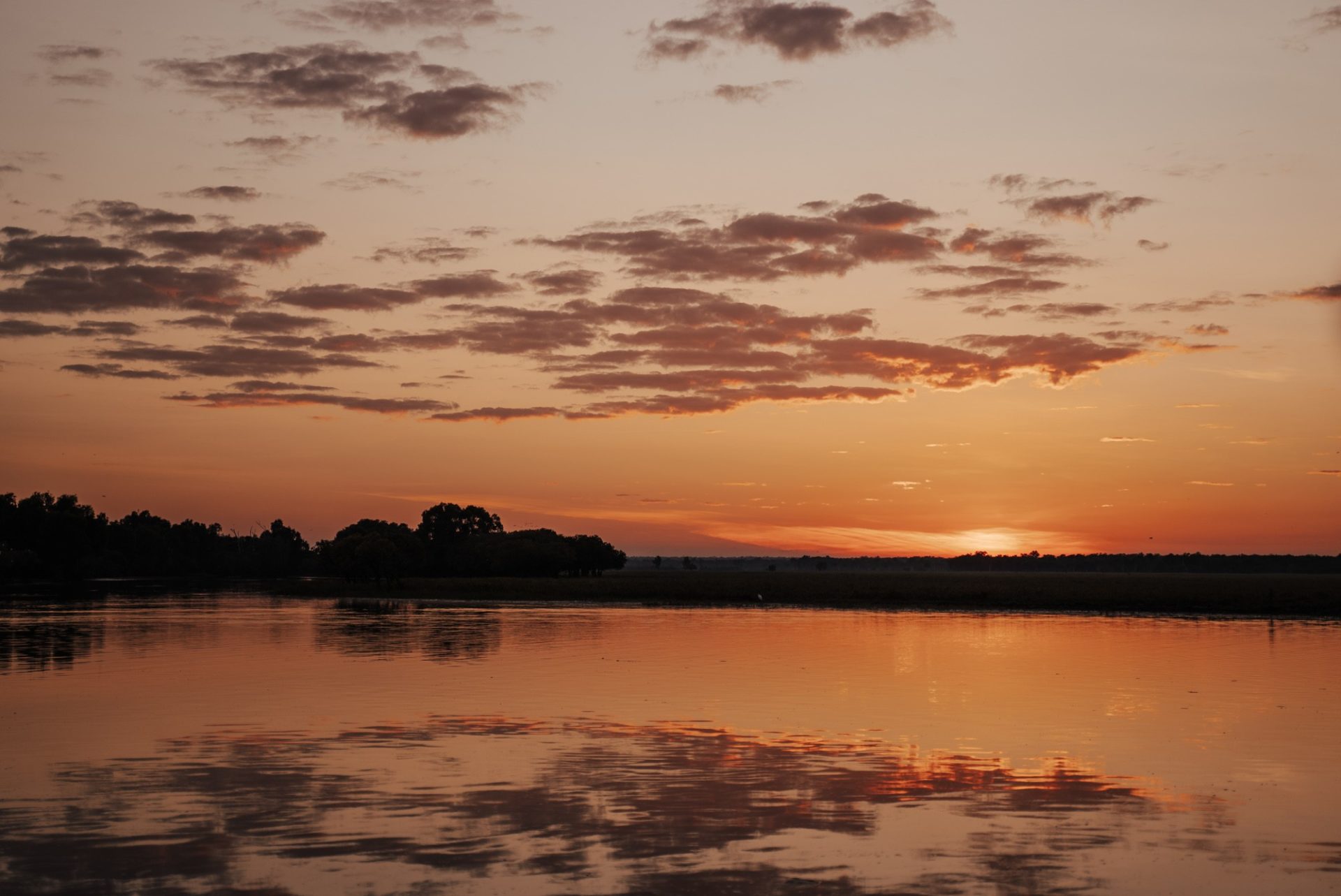
Kakadu Regions
Kakadu covers a huge area across the Top End of northern Australia. To make it easier to navigate and plan your time, Kakadu is often broken down into seven different regions. Each region is know for its own sights and unique natural habitat.
South Alligator Region
If you’re driving to Kakadu from Darwin on the Arnhem Highway, the South Alligator region is the first part that you will come to once you enter the national park. The area is characterized by one of the major river systems, the South Alligator River and Mamukala Wetlands. This region is home to a significant diversity of birds, fish species and other wildlife.
There are some walks at the wetlands, as well as some great fishing opportunities along the river. The highlight of the region is Mamukala Wetlands, known for its wonderful bird watching shelter.
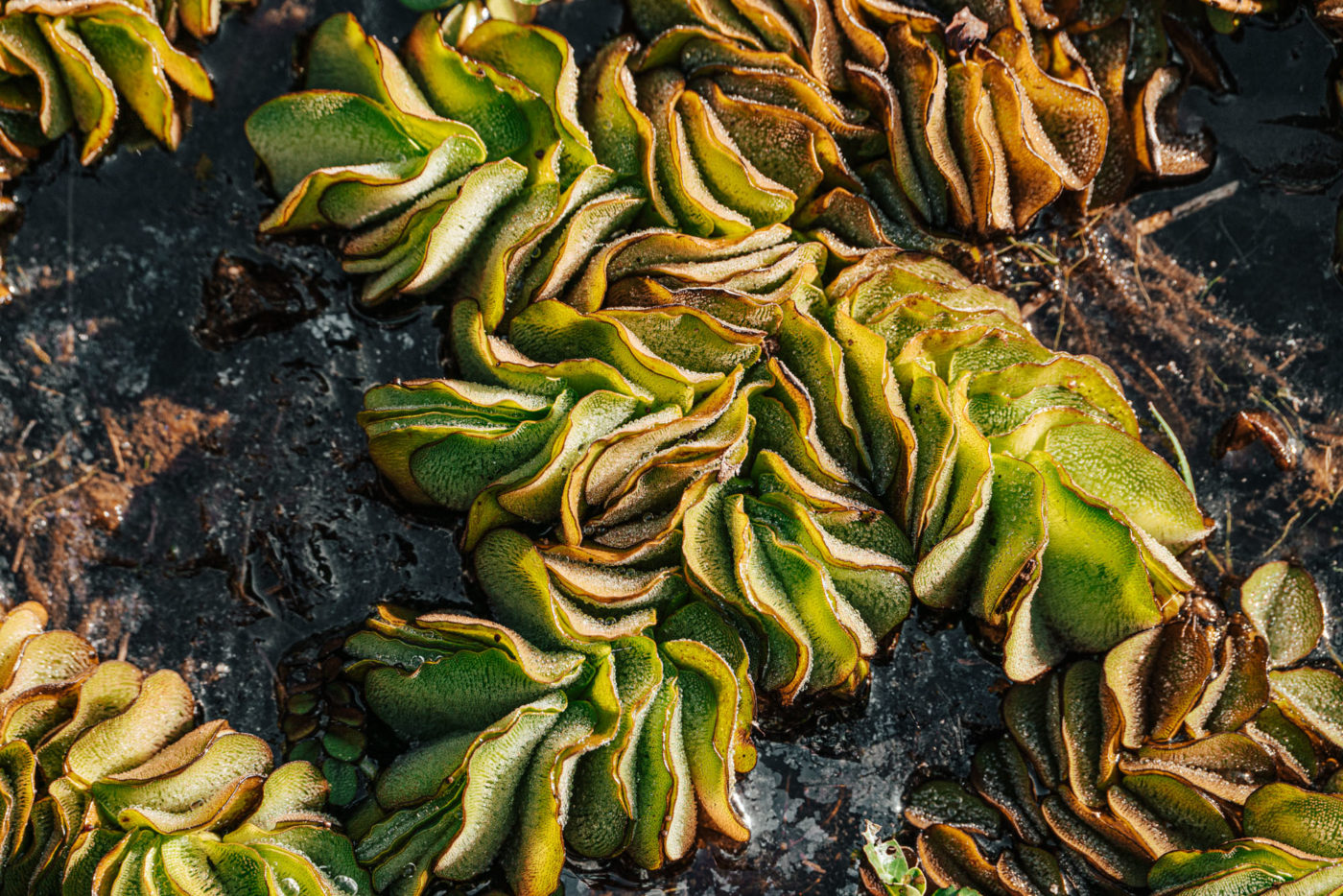
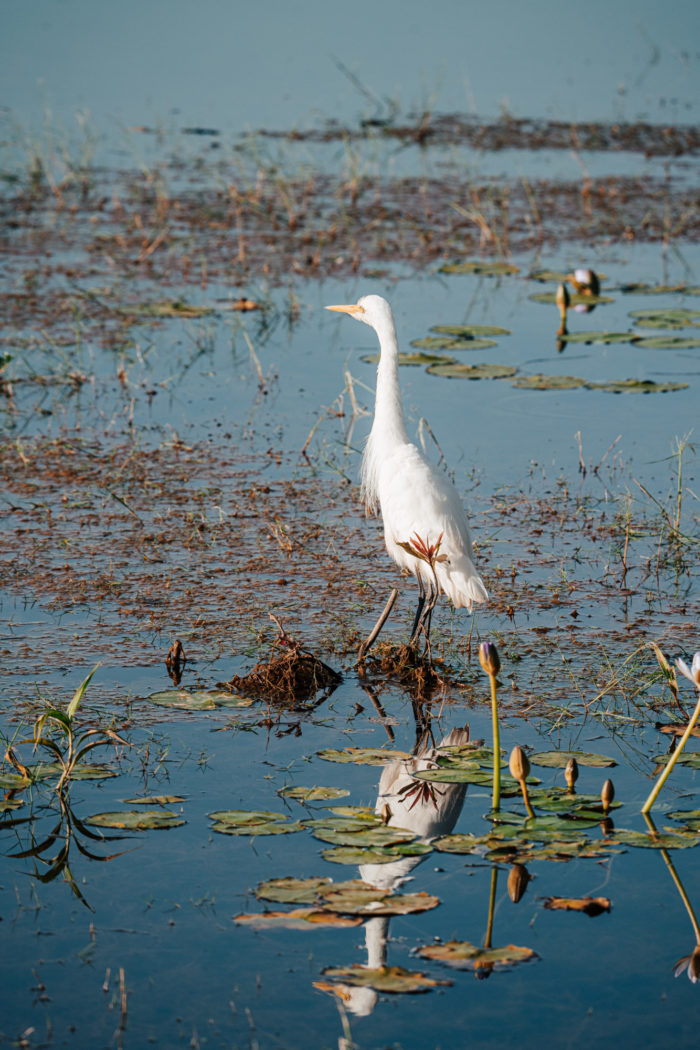
Jabiru Region
Jabiru is the main (and only) town in Kakadu National Park. It was originally established for the uranium mine nearby, which has recently been shut down. It provides visitors with all the essential services and facilities, including fuel, food and accommodation. It’s the main tourism hub for exploring the entire national park, as it’s the only place with reliable phone reception and good accommodation options.
Just outside of town, you’ll find Kakadu National Park information at the Bowali Visitor Centre. There are also a few easy walks in the region.
East Alligator (Erre) region
As one of the highlights of the Kakadu region, the East Alligator River is the border and gateway into Arnhem Land. This part of the stone country is home to World Heritage-listed rock art at Ubirr, some of the best crocodile spotting areas along the river and at Cahills Crossing, as well as nice bushwalks. Most people who visit Kakadu try to visit the East Alligator region for sunset to enjoy the rock art and witness the spectacular Ubirr sunset.
Burrungkuy (Nourlangie) Region
Home to more famous rock art, the Burrungkuy region is located south of Jabiru on the Kakadu Highway. It’s home to the impressive Burrungkuy and Nanguluwurr rock art sites, as well as some dramatic viewpoints across the surrounding area. There’s plenty of nice walks to explore, such as at the Anbangbang Billabong, which is incredible for bird watchers.
Yellow Water (Ngurrungurrudjba) Region
Further down the Kakadu Highway, the Yellow Water region is characterized by the floodplain of the South Alligator River. This incredible wetland is most famous for Yellow Water cruises. These boat tours, departing at either sunrise or sunset, allow visitos to experience the magic on the river and to catch a glimpse of the vibrant bird and wildlife activity.
This region is also home to the very interesting Warradjan Aboriginal Cultural Centre, where you can find interesting arts and crafts for sale by indigenous people.
Jim Jim/Twin Falls Region
One of the only regions accessible only with a 4WD, the Jim Jim and Twin Falls area is home to the best thundering waterfalls and swimming holes in the national park. Jim Jim is a dramatic tumble of water over a towering escarpment and is one of the most photographed parts of Kakadu.
You can see this whole area can from above during the wet season, but in the dry season, the 4WD tracks and hikes to the falls offer a fun adventure in Kakadu Park.
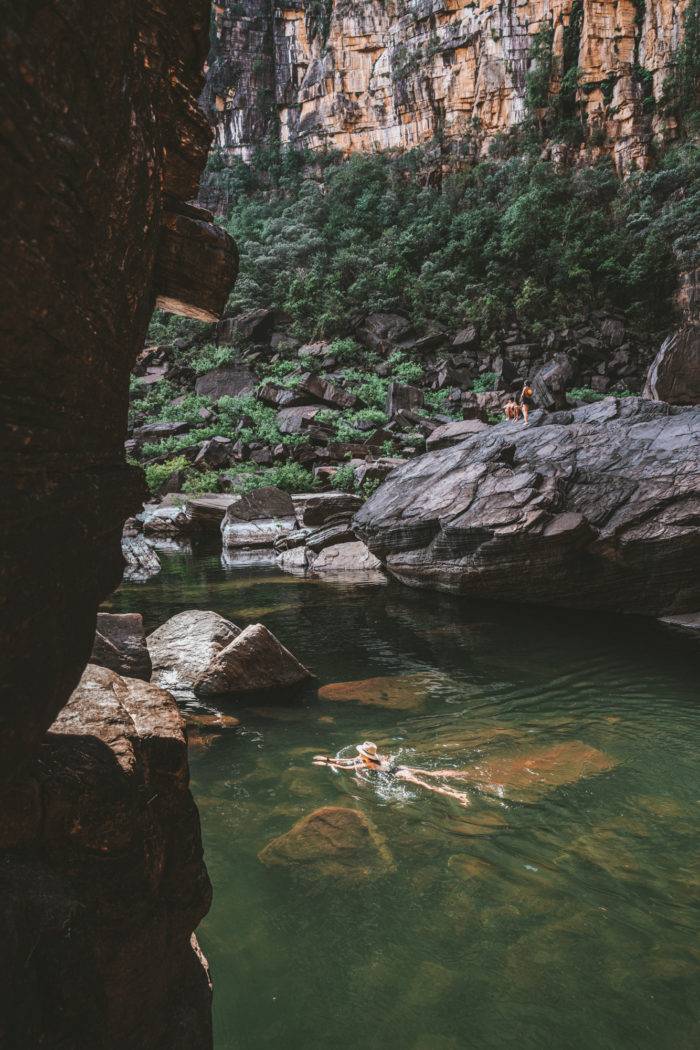
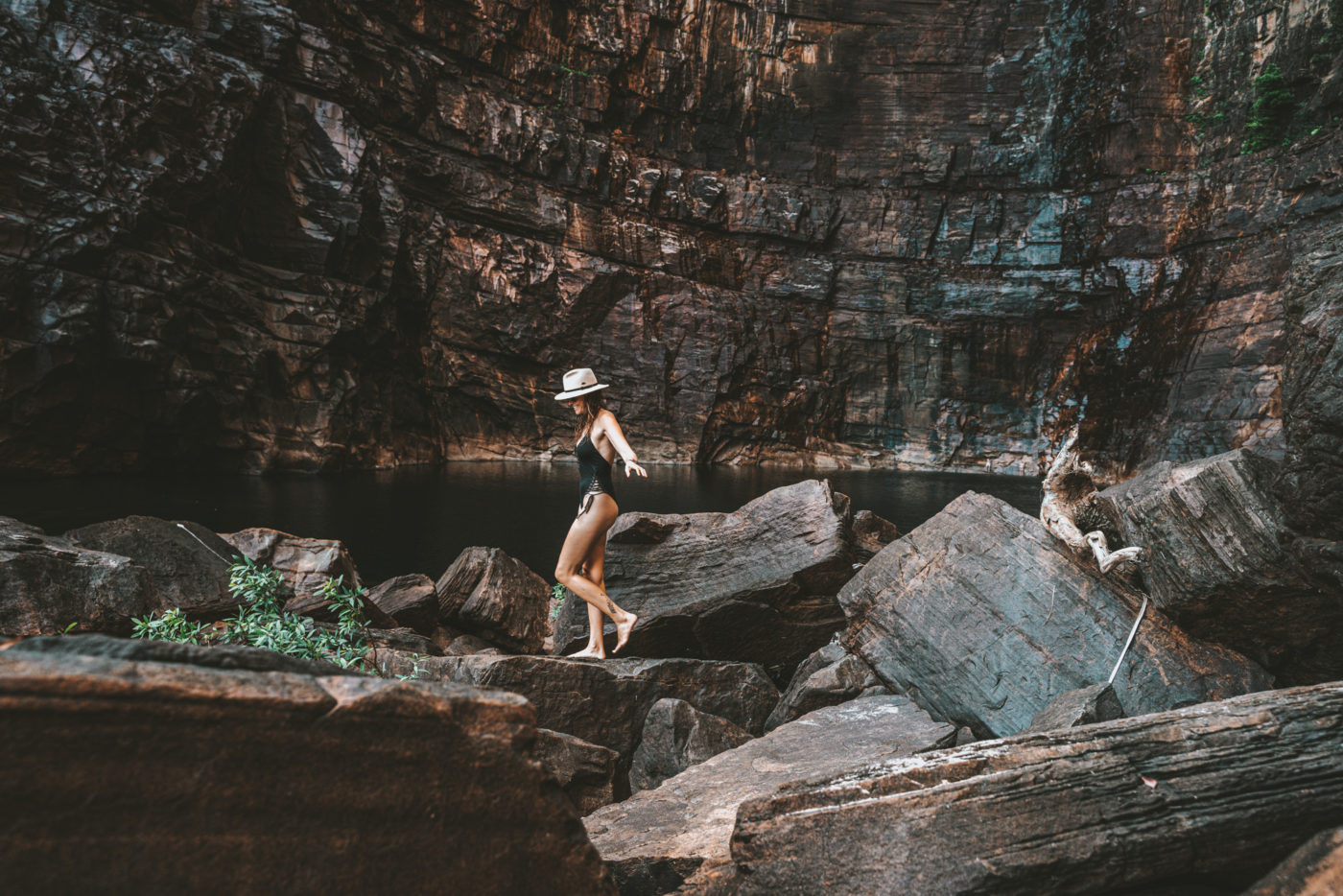
Mary River Region
The first region as you enter the national park on the Kakadu Highway, Mary River region is most well-known for its plunge pools and hiking trails. The two highlights are Gunlom, a popular camping area and natural infinity pool, and Maguk, a small waterfall and camping area.
Things to do in Kakadu National Park
If you’re wondering what the best things to do in Kakadu National Park are, then here are our favourite places that you should definitely visit during your trip.
Mamukala Wetlands
Mamukala is a must for any bird watcher. This incredible wetland area is located just off the highway before you reach Jabiru coming from Darwin. It’s accessible by 2WD, so anyone can appreciate the beauty of this place. There is a wonderful bird-watching shelter, an ideal spot to look out over the water. Otherwise, for energetic types, there is a 3km walk that starts from the car park. The trail doesn’t offer views of the wetlands but offers a nice opportunity to stretch your legs.
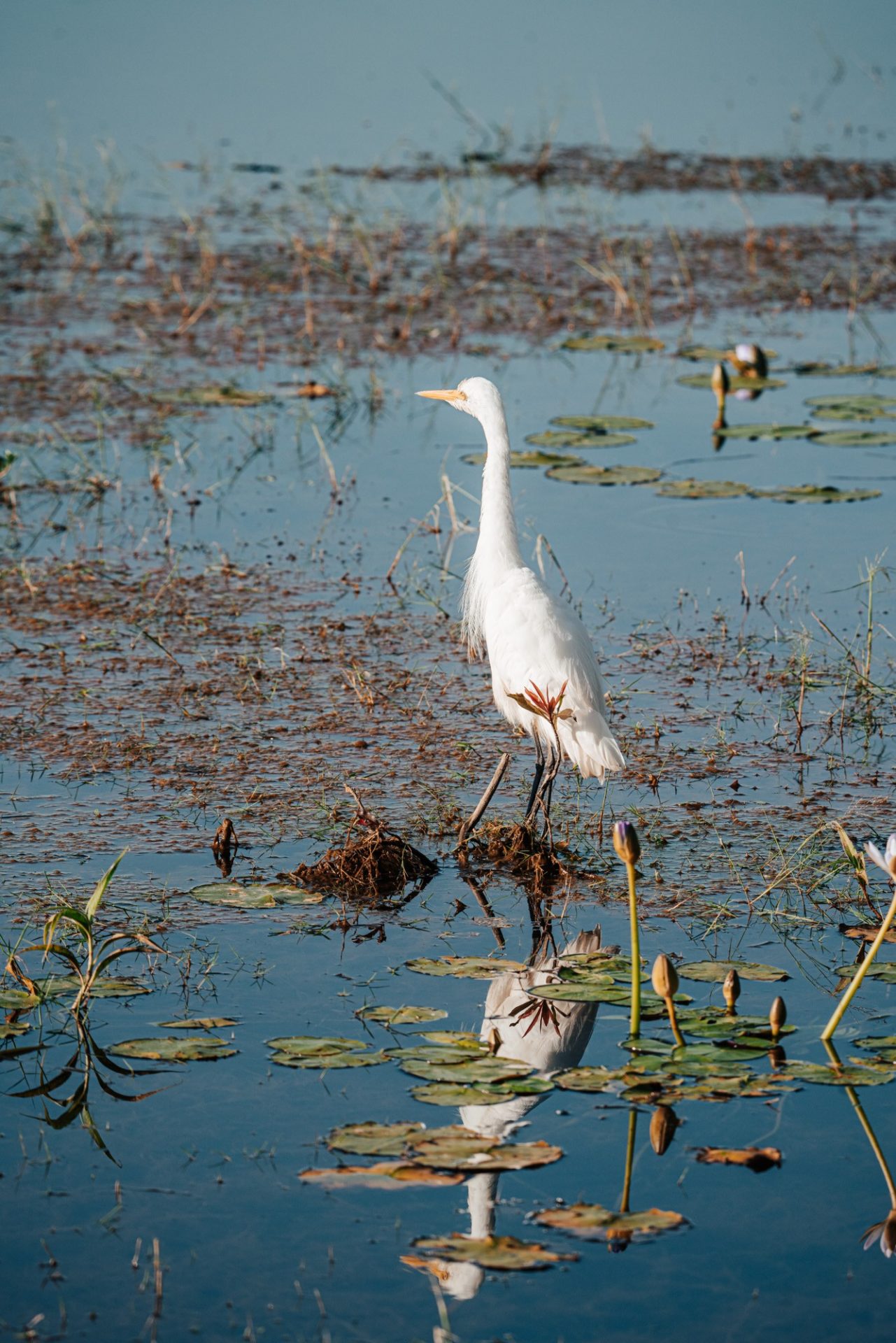
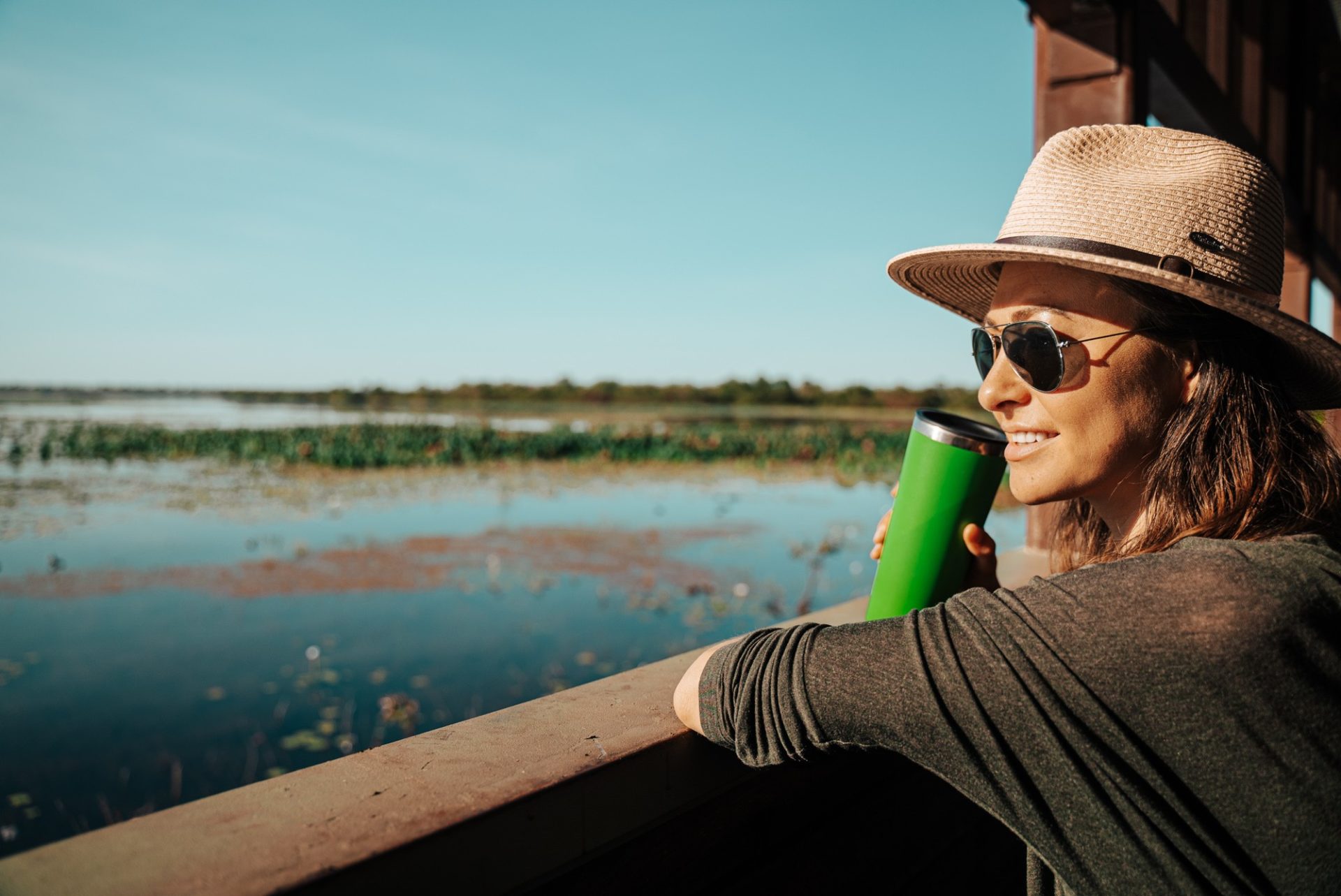
Ubirr Rock Art & Sunset
Ubirr is one of the must-see Kakadu attractions. Admiring the World Heritage rock art is one of the best ways to appreciate the ancient culture of the Traditional Owners. There is a relatively flat 1km circular track that takes you past several rock art sites with information boards.
This is one of the walks in the park that can be done on a Free Guided Ranger Tour. These tours are a new addition to Kakadu and allow visitors to hear stories about the land from the traditional owners. The guided ranger tours operate at Ubirr throughout the dry season. You can check the schedule online or at the Bowali Visitor Centre near Jabiru.
The tour typically starts a few hours before sunset and ends before a moderately steep climb to the top of the rocky escarpment. The views here make it incredibly worthwhile and it’s known as the best place to watch sunset in Kakadu. You can look straight across into Arnhem Land in one direction and across the Kakadu wetlands in the other. Ubirr is easily visited on a half-day trip from Jabiru and is a trip best done in the afternoon.
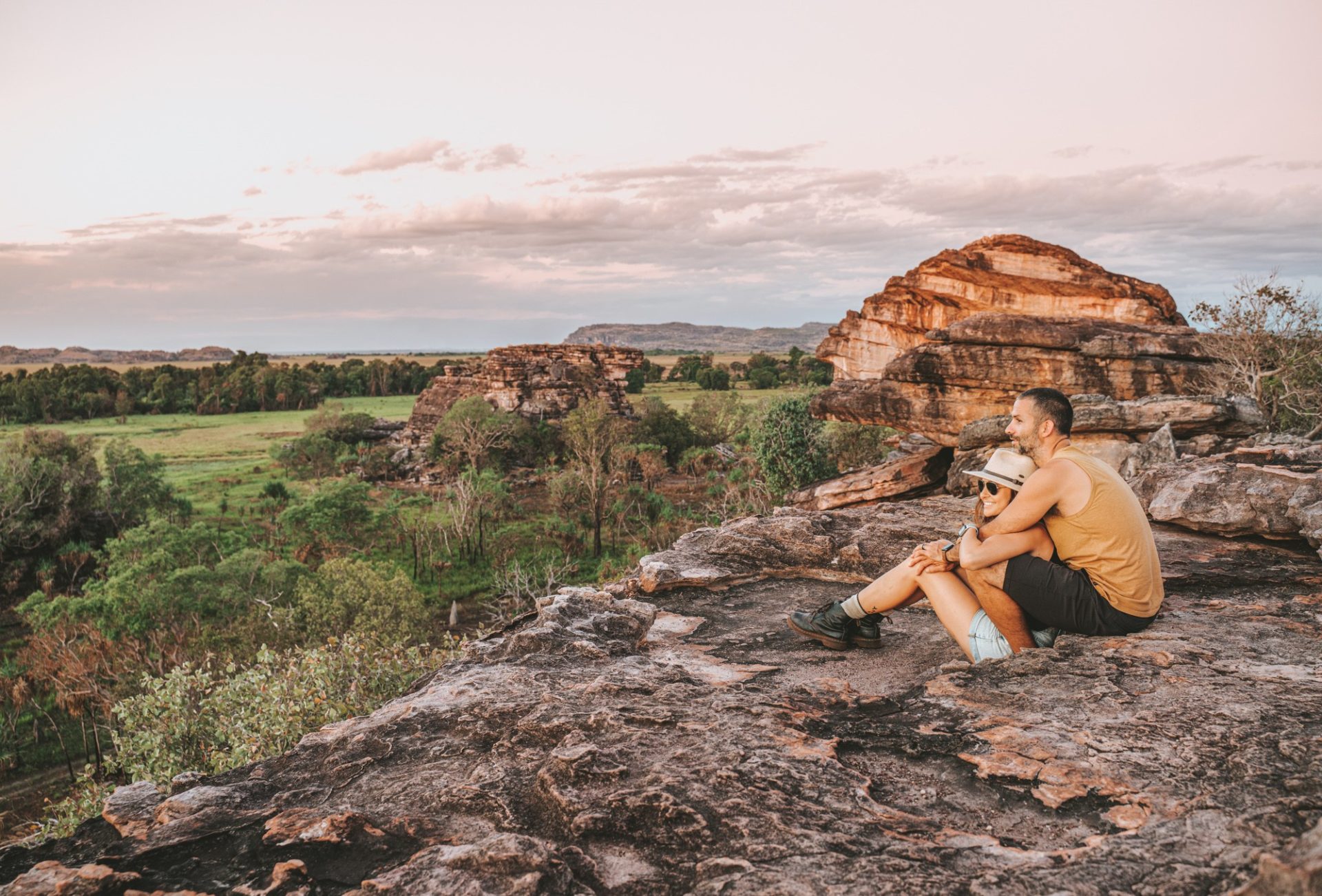
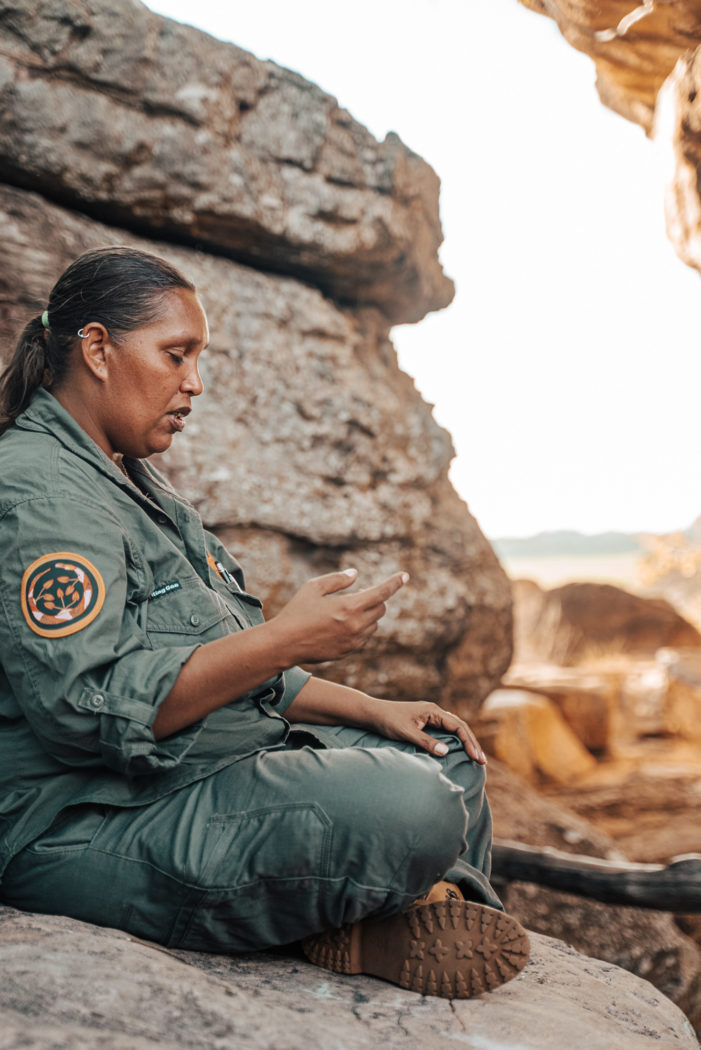
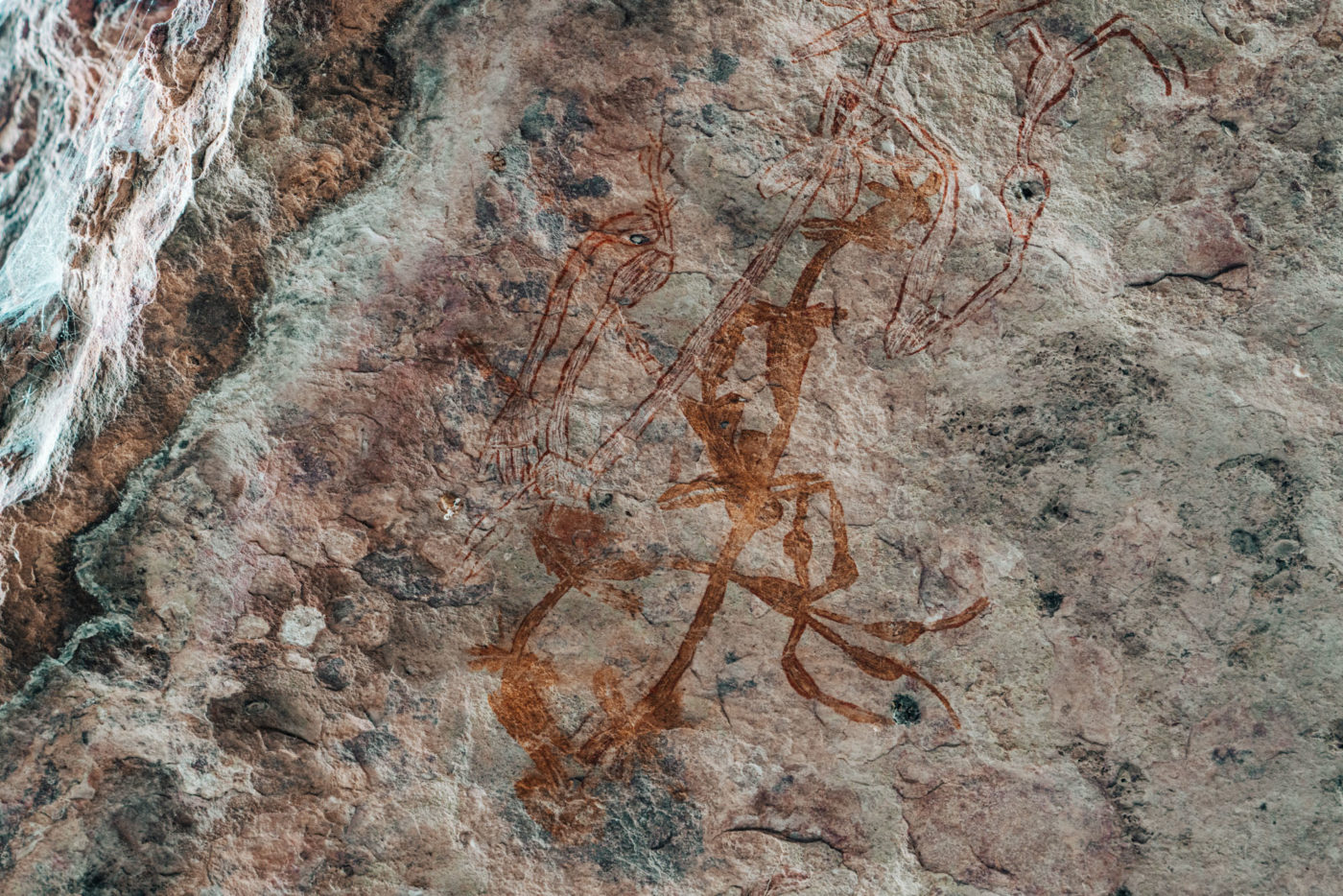
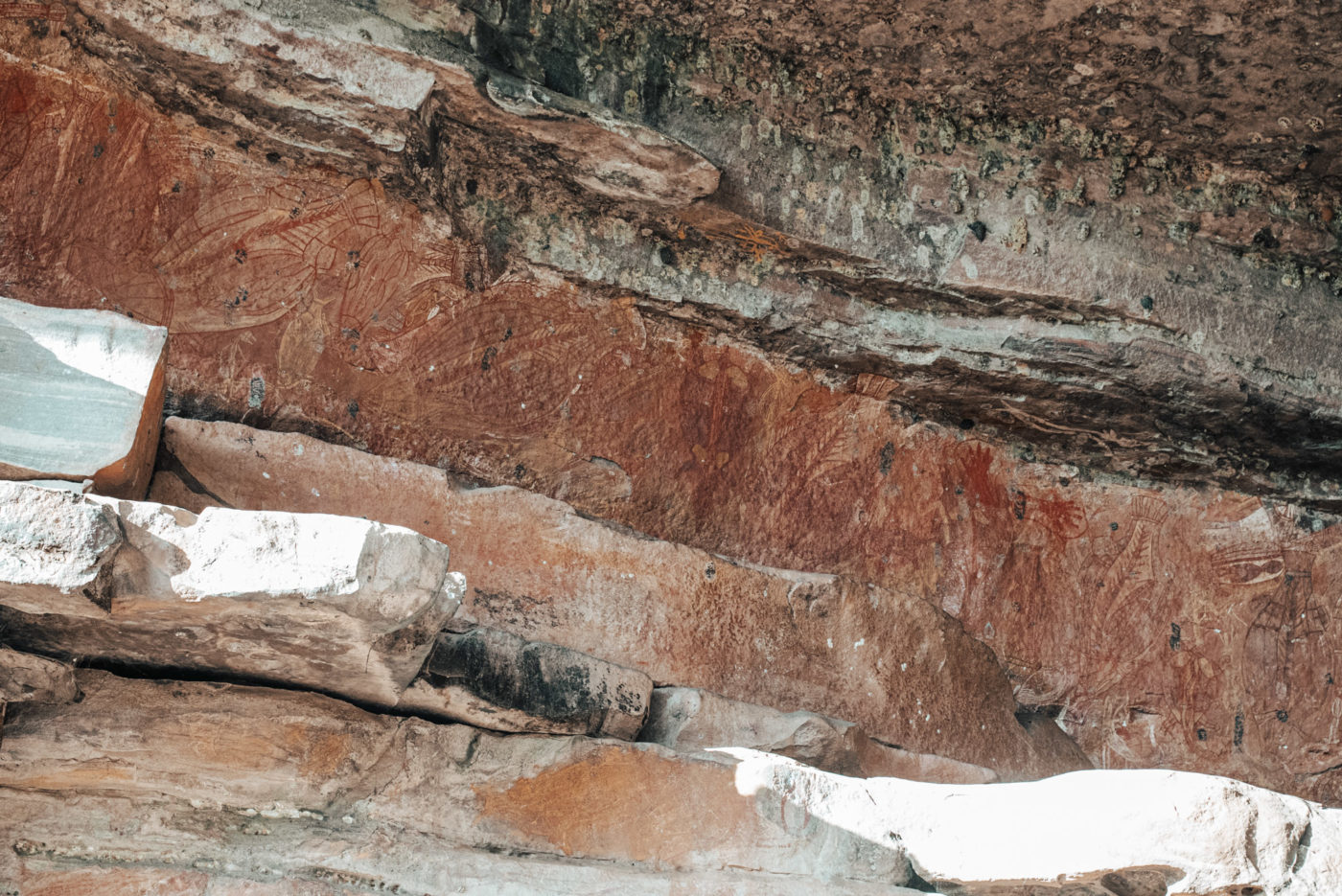
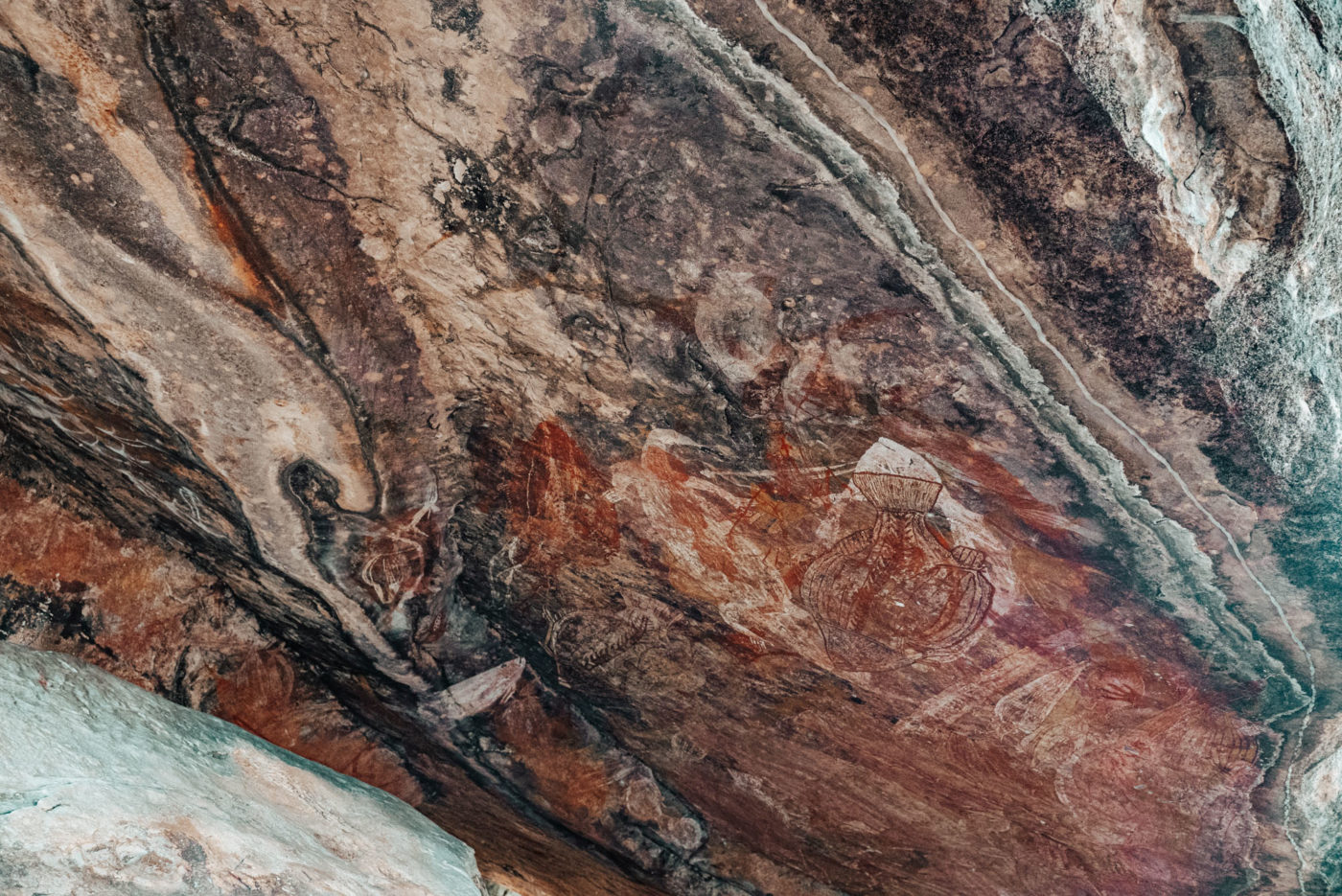

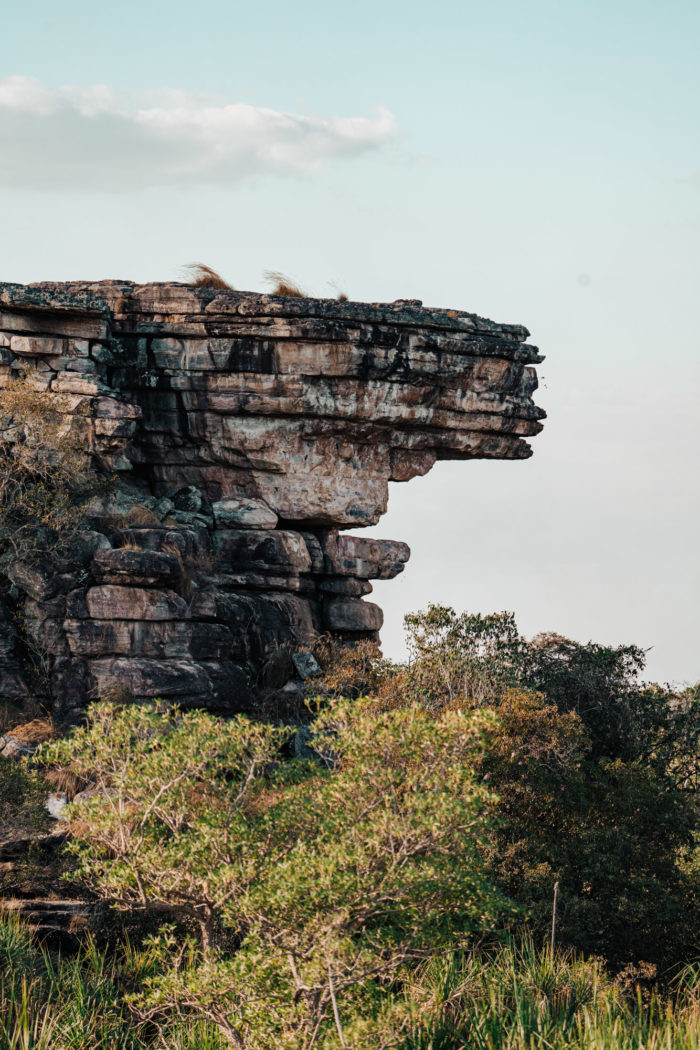
Cahills Crossing
Just before you turn off to Ubirr, you’ll reach Cahills Crossing where the highway meets the East Alligator River. This is the famous crossing that takes you into Arnhem Land (permits must be obtained ahead of time) However, it’s also one of the best crocodile viewing spots in the whole national park.
There is a viewing platform overlooking the river and crossing where you can sit and watch for crocs. You can almost guarantee to spot at least one! At high tide, you can watch the river completely wash over the road and you’ll likely see quite a few crocs at this time looking for fish.
Jabiru
Jabiru is the main town in Kakadu and is where you can refuel and restock. The quiet town has a decent IGA supermarket, fuel station, post office and plenty of accommodation choices. Pop in here to visit the Visitor Centre or to check out some of the trails just outside of town.
Burrungkuy (Nourlangie) Rock Art
Burrungkuy is another incredible Aboriginal rock art site in Kakadu. It’s recognized internationally as one of the most impressive collections of ancient art. From the carpark, there is a 1.5km walk past an impressive Aboriginal shelter and several rock art locations, which document generations of Aboriginal people, from 20, 000 years ago up to the first European contact.
This is one of the most important archaeological sites in Australia and is part of the reason that Kakadu was recognized by UNESCO for its Aboriginal culture. The Burrungkuy Rock Art is another tour offered as a part of the Free Guided ranger programs.
There are two wonderful lookouts here as well. You can walk to the Kunwarddewardde lookout, which provides incredible views over the Burrungkuy area. Or, further back down the road, you can walk up the steep rock face of the Nawurlandja lookout, which offers even better views over the savannah and rugged escarpments of Arnhem Land, particularly at sunset.
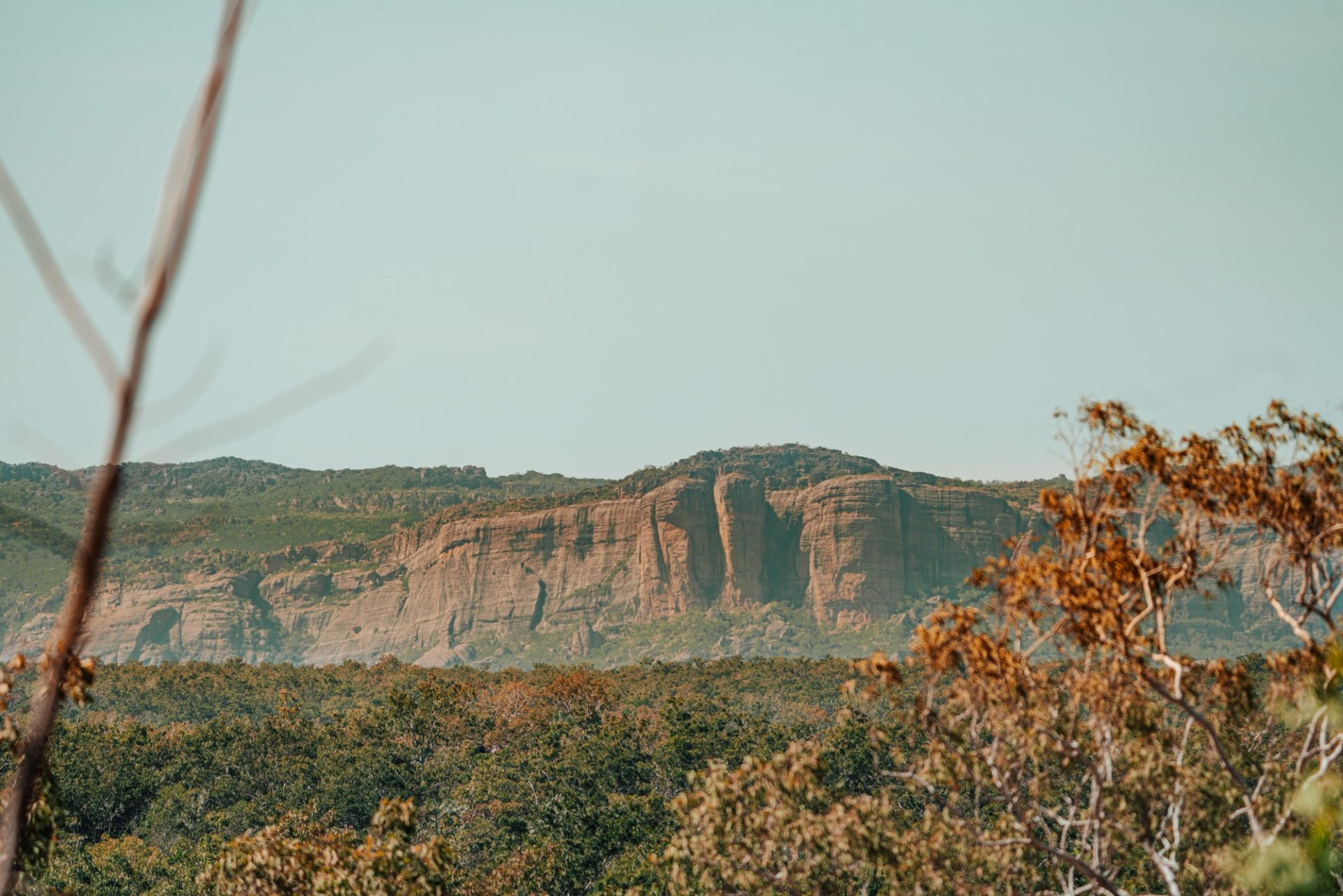

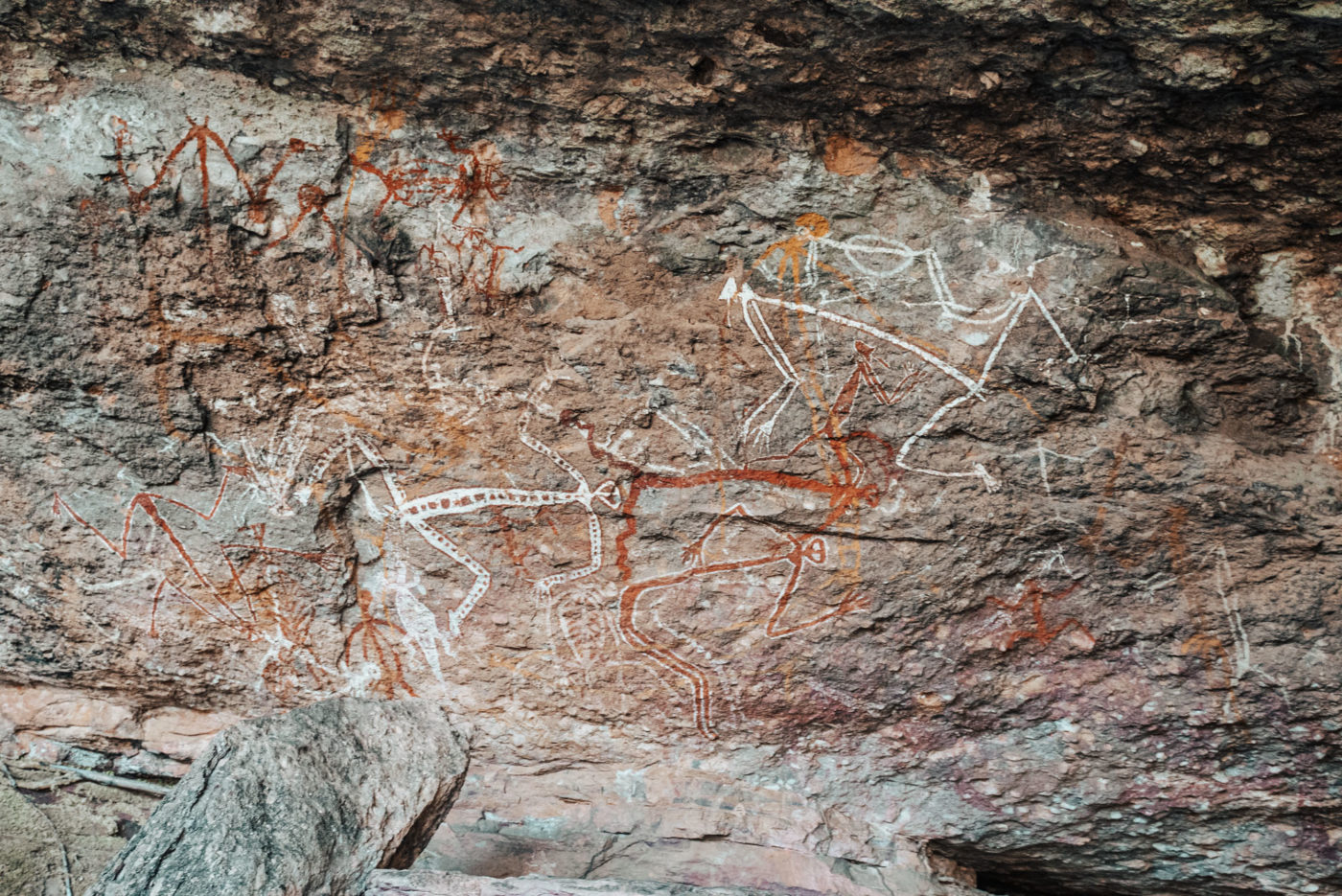

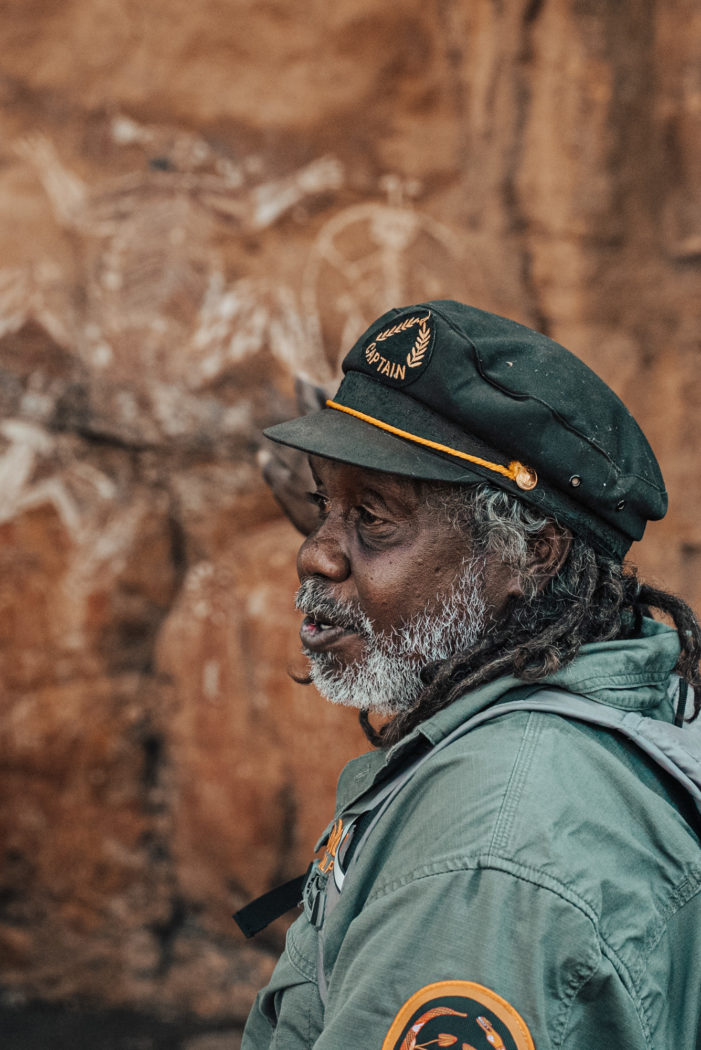
Yellow Water Cruise
The best way to really get to see Yellow Water Wetlands is on a cruise. As one of the best Kakadu tours, the Aboriginal-owned Yellow Water Cruises takes you right out onto the water and guides you through wildlife spotting, bird watching and other life on the river. The boat trips operate year round and throughout the day, although we definitely recommend a sunrise cruise for the most magical experience.
You can find about one-third of Australia’s bird species in Kakadu and Yellow Water Billabong. It is one of the best places to see them. You’ll also get to see crocs up close, particularly in the morning and late afternoon.
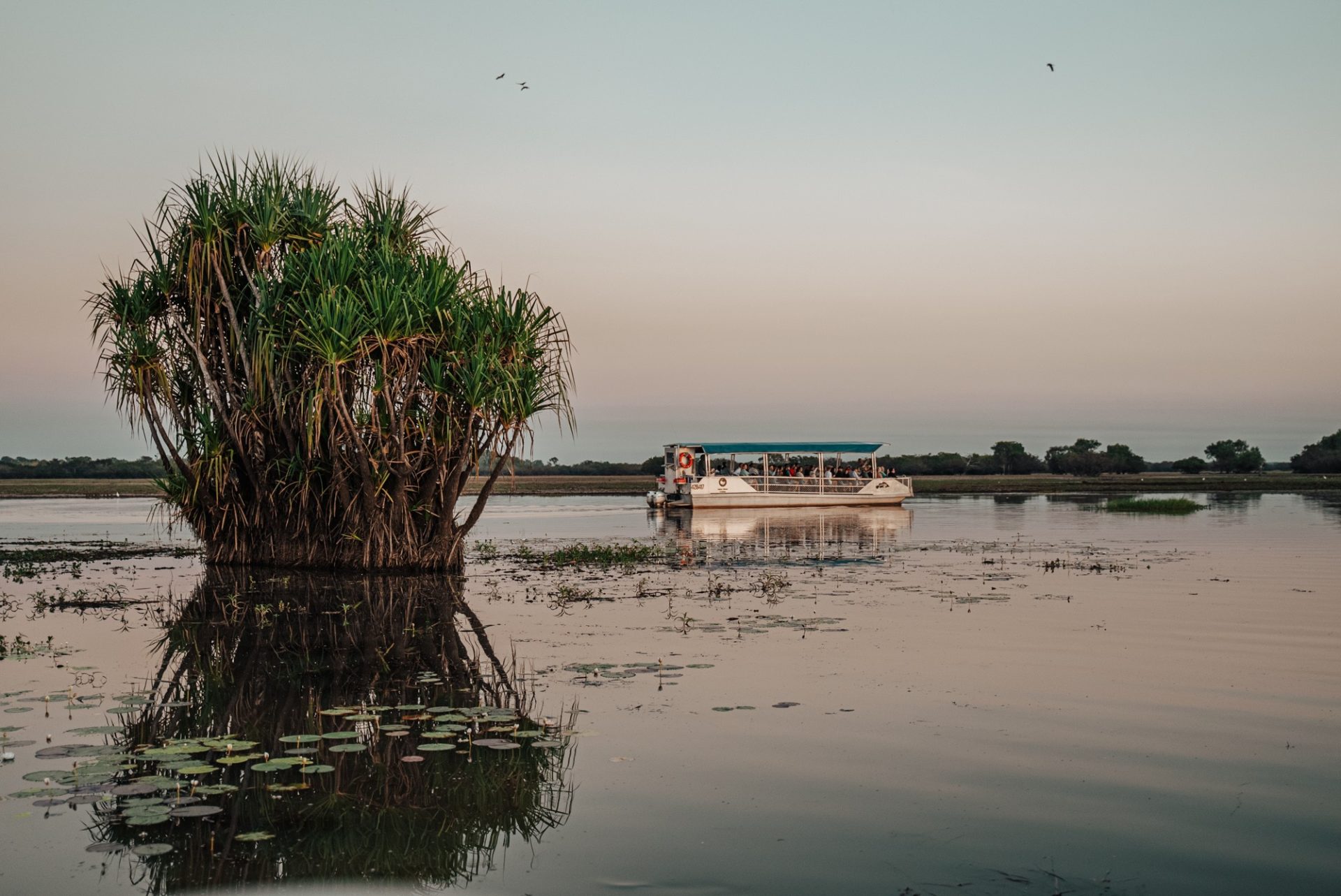
Jim Jim Falls
As one of the most impressive sights in Kakadu National Park, Jim Jim Falls is a must-do for those with a 4WD. The incredible waterfall tumbles over a dramatic escarpment and is at its most impressive in the wet season. In the dry season, you can reach the falls by a rough 4WD track and then walk 2km through monsoon forests to the deep plunge pool at the base.
It’s definitely one of the most beautiful waterfalls you’ll see in the Northern Territory. Don’t underestimate the access to these falls though, the 4WD track is rough and requires some off-road experience.
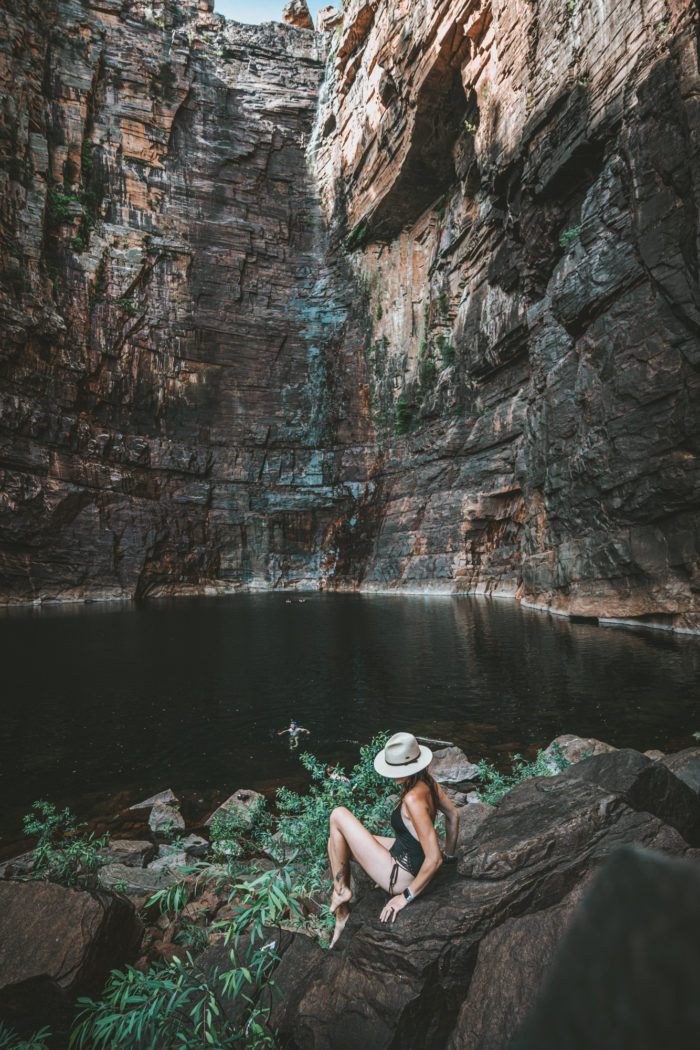
Gunlom Falls
Gunlom Falls is well-known for its natural infinity pool that forms at the top of the waterfall in the Mary River region. There is a 2km return track which takes you along a steep climb to the top for incredible views and a chance for a swim.
When we visited these falls were closed due to disagreements between the Bininj/Mungguy people and the Australian government over the joint management and environment protection of the area. It’s likely to be closed for a few more months, but check the latest news to find out if it’s been resolved.
Maguk
An incredible 2km return walk through an open forest and along a rocky creek leads to a small waterfall and plunge pool. There is also a nice campground here if you want a more secluded experience compared to the Jabiru caravan park.
The rough road to get into Maguk is recommended for 4WD only, although we saw a couple of people trying to get through with their 2WD!
Where to Stay in Kakadu
Kakadu National Park has accommodation to suit a range of budgets. From the many parks managed campgrounds to the resorts and hotels in Jabiru, you’ll find plenty of places to stay in Kakadu for your trip.
Kakadu Campgrounds
There are plenty of national parks managed campgrounds throughout Kakadu. Most have basic facilities including toilets and non-drinking water, while others have slightly better facilities including showers.
Some of the most popular camps include:
- Merl Campground: This spot is just 3km away from Ubirr, it offers a nice base to explore the rock art site and Kakadu walks along the East Alligator River. It has toilets and showers available. Prepare for an extraordinary amount of mossie, midgies and other bugs that inundate this campground.
- Mardukal Campground: This popular camp is on the Kakadu Highway not far from Yellow Water, making it a nice place to explore the wetlands. It has toilets and showers available.
- Maguk Campground: A great bush camping spot not far from the plunge pool and one of the smaller Kakadu waterfalls. Only basic toilets are provided.
All campgrounds in Kakadu fill up on the first-come-first-serve basis, so plan to arrive at the campground around 9-10am to snatch the spots as other campers are checking out.
Kakadu hotels
Mercure Kakadu Crocodile Hotel
The Mercure Kakadu Crocodile Hotel is located right in the middle of Jabiru town. This famous crocodile-shaped hotel has air-conditioned rooms, a swimming pool, bar and a restaurant and is within walking distance to the shops in town.
Aurora Kakadu Lodge Caravan Park
This is the only Kakadu caravan park that you’ll find in the entire national park area. It’s located at the start of Jabiru town, which makes it easy to do self-drive Kakadu day tours to various places in the park. They have plenty of room for all sorts of caravans, vans and tents, with unpowered and powered sites.
Cooinda Lodge Kakadu
The Cooinda Lodge Kakadu is the closest accommodation to the Yellow Water Billabong. The lodge has plenty of accommodation for everyone from beautiful rooms to powered and unpowered camping sites. Cooinda Lodge Kakadu also has a swimming pool, bar and bistro and fuel station.
Tips and advice for visiting Kakadu National Park in Northern Territory
- There are free ranger-guided activities available. These are incredibly informative and will leave you with a greater understanding of the relatively intact landscape and culture in Kakadu. Bookings are recommended on their website.
- There are six Kakadu seasons recognized by Traditional Owners. It’s best to be familiar with the season that you’re visiting so you can pack accordingly and plan your time.
- Early morning and late afternoons are the best time to explore the national park and avoid the high temperatures. Sunrise and sunset are also when wildlife are most active and the lighting is best for photographs too.
- Some of the 4WD tracks can be rough, so ensure that you have a reliable vehicle and plenty of experience. If renting a car, check with your company if you can take it off-road or on unsealed roads.
- Check road conditions and croc updates before setting out at Bowali Visitor Centre near Jabiru. Roads can close due to rain in the Kakadu wet season and some waterfalls might close due to croc sightings, so be aware and adhere to park signs.
- Be aware of potential bushfires during your time in the national park, especially in the dry months. Keep in mind that controlled burning is common, especially using the traditional methods of the Aboriginal people, so check on the NT Fire Incident Map for any out-of-control burns listed by the Northern Territory government.
How many days do you need in Kakadu?
While Kakadu is quite a huge area, the two main highways leading to Jabiru make it easy to access most of the attractions. Distances are vast and many of the unsealed roads are rough, making travel times long. You should allow at least 3-4 days to see most of the main sights, but longer if you plan on seeing all of the Kakadu National Park attractions listed above.
If you don’t have a 4WD, then you will be more limited with how you can experience Kakadu and you will only need 2-3 days to see places accessible on sealed roads. There are also plenty of Kakadu National Park tours to join if you want to see more in a short time.
Kakadu is an incredible place to explore and one of the must-see national parks in Australia. It’s easy to see why it’s famous around the world for both its cultural and natural values. Whether it’s an Ubirr sunset or exploring the four major river systems, it’s such a special place that you’ll remember for a long time after leaving.
READ Next: Guide To Visiting Litchfield National Park In Top End

